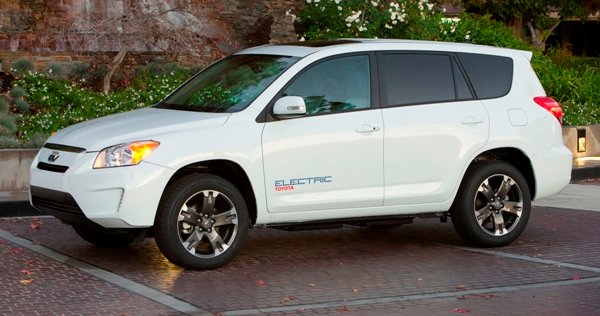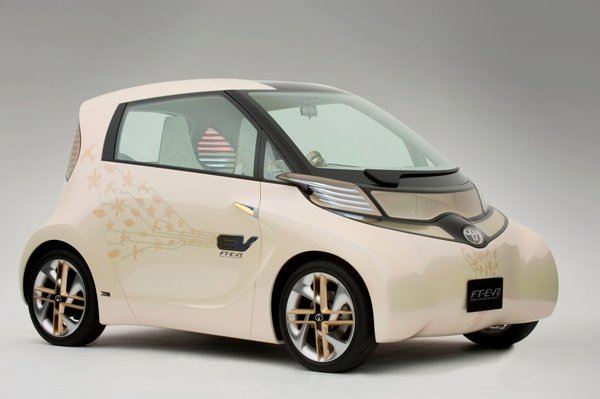Fourth part in a series on the state of electric cars for American consumers
Toyota – not going it alone with their new EV
Toyota chose to introduce the new RAV4 EV at the 2010 Los Angeles International Auto Show with these words by Jim Lentz, President of Toyota Motor Sales USA:
Ladies and gentlemen, it is my pleasure to introduce the second-generation Toyota RAV4 EV … powered by Tesla.
To reveal your new electric vehicle (EV) to the world, acknowledging that it is not your technology under the hood says as much about your company as it does about your vehicle. Clearly Toyota did not think that EV development was an important enough topic to devote their own vast resources, research and development. Toyota arguably leads in the hybrid market. Perhaps they think this is enough.
As alluded to during the introduction, this is not Toyota’s first RAV4 EV. The RAV4 began life in 1994 as a conventionally powered internal combustion engine (ICE) vehicle powered by a 4-cylinder engine. In 1997 Toyota made available an electric version offered only in California to meet California’s Zero Emission Vehicle mandate at the time. Over six years Toyota produced and sold or leased 1,484 RAV4 EVs. When full production is reached, Nissan will make over 2 1/2 times that many each month. Today almost half of those original RAV4 EVs are still in operation. These early EVs were powered by a 27 kilowatt hour Nickel Metal Hydride battery pack which provided a range of 80 to 120 miles and a top speed limited to 78 miles per hour. Some of these vehicles have exceeded 150,000 miles on the original battery pack. Most of these early RAV4 EVs were fleet vehicles, though 328 made it into the hands of the public according to Toyota.
Moving on to the current generation vehicle, Mr. Lentz referred to its development as consistent with a typical mid-cycle “major-minor” product change of an existing vehicle. In other words, it has not been developed as an electric vehicle. It is a conversion of existing RAV4 technology. One might wonder why this should be a significant consideration. Consider these comments made by Mr. Lentz at the unveiling:
This added weight factor also required significant re-tuning of major components and a focus on weight distribution. Not only were suspension and steering modified significantly major components needed to be re-located to better balance the increased mass.
The LEAF was designed as an electric vehicle. It is not a derivative of an existing platform. This is important because the car can be designed optimally rather than compromising an existing design to implement a drivetrain variance. Look for a future article on this topic.
The RAV4 EV is currently in what Toyota refers to as Phase Zero. This consists of 35 demonstration vehicles being placed in use by the end of this year, and running through most of next year. Phase One will be “thoroughly re-engineered” vehicles brought to market in 2012.
Because of the marriage of two companies to produce this vehicle, some logistical issues still need to be addressed according to Mr. Lentz. For instance, the RAV4 is produced in Canada, and they expect the RAV4 EV chassis to come from the same plant. Tesla will produce the battery and powertrain components in Palo Alto, California. Final assembly location, battery power and power output decisions have yet to be finalized. He also states that there have been no decisions made on business model, volume or pricing considerations. It sounds to us as if there are a significant number of issues that need to be addressed in a reasonably short developmental time for this new technology vehicle, along with combining the processes of two manufacturing partners that have never worked together before.
Toyota is also looking at bringing another ICE conversion vehicle to market as an EV, based on the iQ micro car available in Japan:
This vehicle in its current configuration is powered by a 1.0-liter gasoline engine with seating for four. iQ came to market in Japan in 2008. Little is known of propulsion plans for the EV version of the iQ, though existing plans call for its EV deployment also in 2012. We fail to see a large market developing for a micro car in the United States – although think (electric) and Smart (gasoline) seem to think that there is a market large enough for them at least. Toyota looks to be joining that micro-share of the market next year.
Perhaps one of the most telling comments came with the introduction of the baby EV in Tokyo:
“Energy-related policies are difficult to predict and vary depending on governments,” Toyota Executive Vice President Takeshi Uchiyamada told the news conference.
Nissan started investigating EV batteries over eighteen years ago. Toyota started in 2010. One of the richest companies (sitting on $23 billion in cash), Toyota could certainly choose any technology to pursue that they feel will position them best for the future. At present, hybrid technology trumps electric technology for them.
Additional Source: Reuters



Pingback: Toyota confirms Scion iQ EV for 2012 — Living LEAF